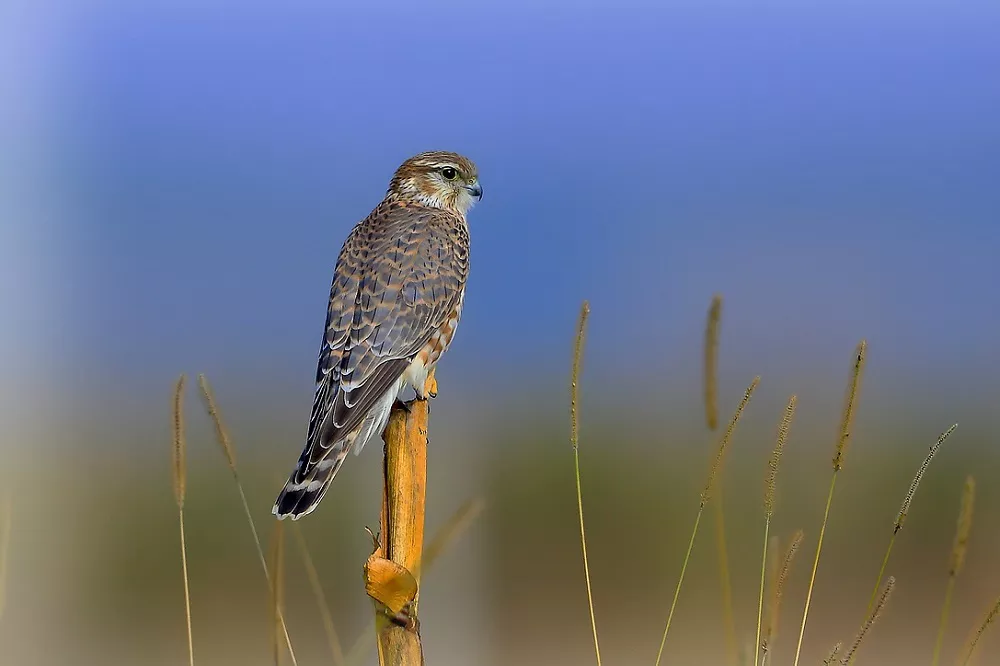The Merlin Falcon (Falco columbarius) is a swift and agile raptor known for its remarkable hunting prowess and impressive aerial acrobatics. As one of the smallest falcon species, the Merlin Falcon has adapted to a diverse range of habitats across North America and Eurasia. This article delves into the dietary habits of the Merlin Falcon, shedding light on the types of prey it relies on for sustenance and the strategies it employs to secure a successful meal.
General Overview of Merlin Falcons:
Merlin falcons are widely distributed across North America, Europe, and Asia. They inhabit a variety of habitats, including open woodlands, grasslands, and coastal areas. These birds are highly adaptable and can be found in both urban and rural environments.
Carnivorous Nature:
Merlin Falcons are primarily carnivorous birds, subsisting on a varied diet composed of small to medium-sized prey. These raptors are highly skilled hunters that utilize a combination of stealth, speed, and agility to capture their quarry. Their feeding behavior is characterized by swift aerial pursuits and surprise attacks, often targeting birds in flight or taking advantage of ground-dwelling creatures.
Prey Selection:
Small Birds: The Merlin Falcon’s diet predominantly consists of small birds. It often targets species similar in size or smaller than itself, such as sparrows, finches, larks, warblers, and other passerines. Merlins possess exceptional flying skills, allowing them to pursue and overtake their avian prey with impressive speed and agility.
Insects: In addition to birds, Merlin Falcons also incorporate insects into their diet. They may feed on a variety of flying insects, including dragonflies, grasshoppers, beetles, and moths. During the breeding season, insects can be an important food source for Merlin Falcons, especially when raising their young.
Small Mammals: While birds form the primary portion of their diet, Merlin Falcons also prey upon small mammals. They may target rodents like mice, voles, and shrews, taking advantage of their ground-dwelling habits. This variety in prey selection allows Merlin Falcons to adapt to different habitats and food availability.
Migration Impact on Diet:
Merlin falcons are migratory birds, traveling long distances during seasonal movements. Their diet may vary depending on the geographical location and time of year. During migration, merlins may consume a wider range of bird species, taking advantage of the abundance of available prey along their migratory routes.
Hunting Techniques:
Aerial Pursuit: Merlin Falcons are known for their rapid and agile flight. They employ a hunting technique known as aerial pursuit, where they chase down their prey in mid-air. With remarkable speed and maneuverability, they launch surprise attacks, often using their sharp talons to capture their victims.
Stooping: Another hunting technique employed by Merlin Falcons is stooping. During a stoop, the falcon folds its wings and dives steeply from great heights, reaching incredible speeds. This swift descent allows them to surprise and overwhelm their prey, delivering a precise and deadly strike.
Ambush: In certain situations, Merlin Falcons may adopt an ambush strategy. They perch on high vantage points, such as tree branches or power lines, and patiently wait for suitable prey to pass by. Once an opportunity arises, they swiftly launch into action, using their speed to catch their unsuspecting prey off guard.
Conclusion:
The Merlin Falcon’s diet consists primarily of small birds, supplemented by insects and small mammals. This raptor species employs various hunting techniques, including aerial pursuit, stooping, and ambush, to secure its meals. Its agility, speed, and precision make the Merlin Falcon a formidable predator in its chosen habitats. By understanding the feeding behaviors and prey preferences of these remarkable birds, we gain a deeper appreciation for their vital role in maintaining ecological balance and the intricate web of life in their respective ecosystems.


 Facebook
Facebook  Instagram
Instagram  Youtube
Youtube 